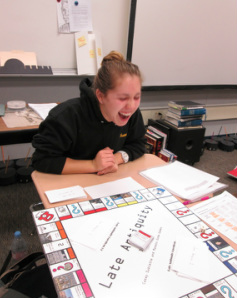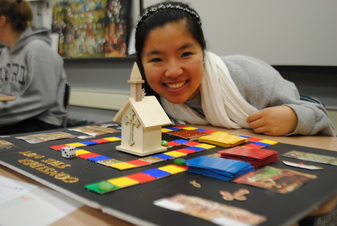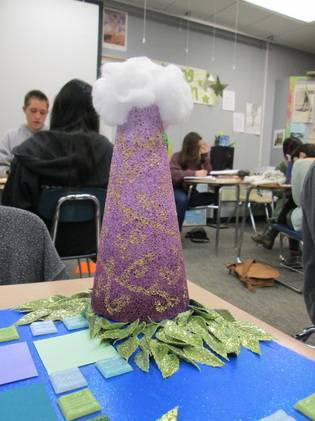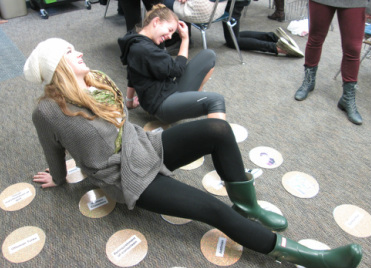Fall Semester Final: Boards Games

Guidelines (pdf)
ForeverGeek.com (really good ideas!)
You will design your own board game that will include reviewing for different time periods that we have already learned about (Mesopotamia through all of Renaissance, including ancient Egypt and Islamic art)
You have TOTAL CREATIVE FREEDOM! (well, almost)
1. Design a game based on a chapter of study (will be chosen at random)
· Think of all the types of games you’ve played to use as inspiration (Pictionary, Candyland, Cranium, Chutes and Ladders, Risk, Don’t Spill the Beans, Apples 2 Apples, Monopoly, The Game of Things...etc.) Pick and choose aspects of these games that you like and maybe incorporate them into your game.
· Materials to use: Foam board, poster board, paint, markers, construction paper.
2. Decide on the type of game you want to design. What do you want the board to look like?
ForeverGeek.com (really good ideas!)
You will design your own board game that will include reviewing for different time periods that we have already learned about (Mesopotamia through all of Renaissance, including ancient Egypt and Islamic art)
You have TOTAL CREATIVE FREEDOM! (well, almost)
1. Design a game based on a chapter of study (will be chosen at random)
· Think of all the types of games you’ve played to use as inspiration (Pictionary, Candyland, Cranium, Chutes and Ladders, Risk, Don’t Spill the Beans, Apples 2 Apples, Monopoly, The Game of Things...etc.) Pick and choose aspects of these games that you like and maybe incorporate them into your game.
· Materials to use: Foam board, poster board, paint, markers, construction paper.
2. Decide on the type of game you want to design. What do you want the board to look like?

(Your board does not have to look anything like this. These are just suggestions.)
3. Make up questions that relate to your chapter. TYPE them neatly on 3” X 5” index cards cut in half. Divide your questions equally between FACT or OPINION (or other information that you and your partner have decided on). Must create AT LEAST 25 cards. They should be an appropriate level of difficulty.
· How you use these question cards to progress the game is totally up to you. Factual questions must have the answer written on the card.
3. Create markers for players to move along the board. They can be “ready-made”!
3. Make up questions that relate to your chapter. TYPE them neatly on 3” X 5” index cards cut in half. Divide your questions equally between FACT or OPINION (or other information that you and your partner have decided on). Must create AT LEAST 25 cards. They should be an appropriate level of difficulty.
· How you use these question cards to progress the game is totally up to you. Factual questions must have the answer written on the card.
3. Create markers for players to move along the board. They can be “ready-made”!

4. Include the basics for the game such as;
a. Rules and Objectives
b. all cards, dice or spinner (if needed), markers, board, additional necessities specific to your game.
c. Set up- What do the players need to do to start playing? How do the players decide who takes the first turn?
5. Has a box for storage. Everything, including the board, markers, pencils, pads of paper, directions, and cards, all need to fit neatly into a box or package. The box needs to be neat and professional looking as possible. Needs to have an attractive/interesting/fun look to it. It should grab people’s attention to make them want to play your game! KEEP IT COMPACT!
Questions to ask yourselves:
1. How much of the game is left to chance (dice/spinner) and how much is controlled by the players?
2. What sort of obstacles do the players have to deal with?
3. What kind of shortcuts or setbacks do players have? (ex. Jump a head 2 squares.)
4. Do players need to reach a number of points or simply reach the “finish line”?
a. Rules and Objectives
b. all cards, dice or spinner (if needed), markers, board, additional necessities specific to your game.
c. Set up- What do the players need to do to start playing? How do the players decide who takes the first turn?
5. Has a box for storage. Everything, including the board, markers, pencils, pads of paper, directions, and cards, all need to fit neatly into a box or package. The box needs to be neat and professional looking as possible. Needs to have an attractive/interesting/fun look to it. It should grab people’s attention to make them want to play your game! KEEP IT COMPACT!
Questions to ask yourselves:
1. How much of the game is left to chance (dice/spinner) and how much is controlled by the players?
2. What sort of obstacles do the players have to deal with?
3. What kind of shortcuts or setbacks do players have? (ex. Jump a head 2 squares.)
4. Do players need to reach a number of points or simply reach the “finish line”?




